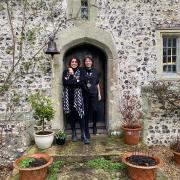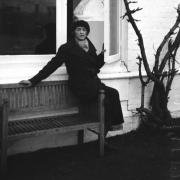Daphne Constantine tells us why she loves her almshouse and about the history of the almshouse movement.
This is a longer version of the article that appeared in the May edition of Sussex Life.
Elderly people now represent a greater percentage of the population than ever before. The babies born around the end of the last World War are becoming pensioners and the provision for their care, their housing, and well being in old age, has become a hot topic. Many people are lucky enough to be financially secure for their lifetime, either through inheritance, or pension advice and careful planning, but others end up in less fortunate circumstances as they grow older.
When I was a child, my mother would frequently make grand utterances about various acquaintances of hers who had made bad financial decisions by saying they were “going to end up in the workhouse!” I think this was designed to give me a feeling of fear of poverty as I grew up, but the phrase always stuck with me. Little did I know that at the age of 63 I would find myself in an almshouse, not such a terrifying sound as a workhouse but originally run on similar principles.
Many villages in England have small terraces of cottages or apartments run by charities and set up centuries ago to house the poor of the parish. When I gave up work, because of arthritis in my hands on a State Pension, I decided to apply and see if I would qualify for a place in one.
There are more almshouses around than one would imagine. Once you are alerted to their presence they seem to appear like mushrooms. The history of them goes back about 1,000 years when the word “hospice” was used rather than almshouse.
ln the 14th century, the word “almshouse” began to be used alongside “hospice”, to mean a place where the poor had refuge and care. “Hospice”, deriving from the Latin “hospes”, meaning a guest, has the same root meaning as hostel, hospital and hotel – a place where people stayed. A hospital was the usual place where the poor ended up in times gone by and meant the poor house, orphanage, almshouse or asylum, where abandoned children, pregnant women, travellers and the poor would be taken in.
Often religion became a base for the provision of care for the less well off. Thus many hospitals bore the inscription in Latin “House of God” and the monks would provide sustenance for the needy.
In Victorian times the building of almshouses reached its heyday and dwindled away afterwards. The giving of alms or amounts of money to charity for the assistance to poorer members of the community was sometimes done with a genuine desire to help the less fortunate but was also associated with buying in Brownie Points with God and the community at large. It also bestowed fame for posterity for the benefactor, as a charitable giver.
Sometimes buildings were specifically built as almshouses, but others were originally intended for another purpose, for example as farm workers’ cottages on a large estate and later came to house the employees as they became too old to serve any longer.
Across East and West Sussex there are over 45 different groups of almshouses and vacancies are usually advertised in the local paper or in the parish magazine. The types of almshouses can vary widely, from being a complex of apartments converted within a very old building, to small cottages with gardens of their own.
The Sackville College in East Grinstead for example, was originally built in the early 1600s as a hunting lodge for the Sackville family hundreds of years ago, but ended up being a place where they put their old retainers, frequently forgetting or ignoring the need to send food or care of any sort. Allegedly there were fatalities as a result. Since then, fortunately, matters have improved and the college, which is another name for hospital or almshouse, is used for some of the elderly of the town. It is a beautiful and peaceful place, within easy walking distance of the shops and public transport and provides a wonderful setting for those lucky enough to qualify for a place there.
Many almshouses allow the tenant or guest to keep a pet, which is recognised as being an important contribution to a person’s wellbeing and prevents the sense of loneliness that the elderly often feel. Usually the almshouse is granted for life and the cost is a monthly rent, or maintenance contribution, as it is often termed, which is generally slightly lower than the usual market rental cost. Sometimes, depending on income, council tax benefit may also be received and a TV licence for all the almshouses in one place, may be included.
The qualifications for being offered a place in an almshouse are usually fairly similar. One must be a retired person over the age of 60 for women and 65 for men, of good character and have connections with the village or location where the almshouse is situated. Additionally, one’s income has to be low and the Trustees of the charity must agree that an almshouse is appropriate for the applicant concerned. In all cases, the final decision is that of the Trustees.
Anyone accepted must be capable of looking after themselves and not too infirm to manage alone. Sometimes there are no vacancies and no foreseeable ones likely to come up. A bit like London buses, there are either several at once or none for ages. Sadly, one often has to wait for the death of one of the occupants before there is a chance of getting a place.
The Almshouse Association can provide lists of charity run almshouses in a specific area but one has to make individual approaches to the Trustees of each charity in order to apply for a place as the Almshouse Association do not play a part in this aspect. The application forms are often long and ask a lot of questions and then if considered suitable, the applicant is usually interviewed in person.
Many almshouses are interesting and antiquated buildings dating back to Elizabethan times or beyond. They have witnessed the comings and goings of countless older people over the centuries and have provided a warm and safe environment for those who have fallen on hard times.
My little almshouse cottage is one of a run of three on Ashdown Forest in a beautiful rural position, making it rather isolated and thus less in demand than almshouses in a town or village. However it oozes character and peace and privacy and I am both proud and grateful to have been granted it. At 200 years plus, it has low ceilings and door lintels waiting to crack my head, but hearing the owls at night and the forest creatures by day is as entertaining, or more so, than watching TV.
With such a boom in the post war generation and so many people living longer than in past centuries perhaps once again the almshouse system will come into its own. It seems to me that it provides a useful and often more individually tailored solution for the elderly, than council assisted flats or a granny annexe.
Find out more
To find out more about almshouses visit the The Almshouse Association website.


























